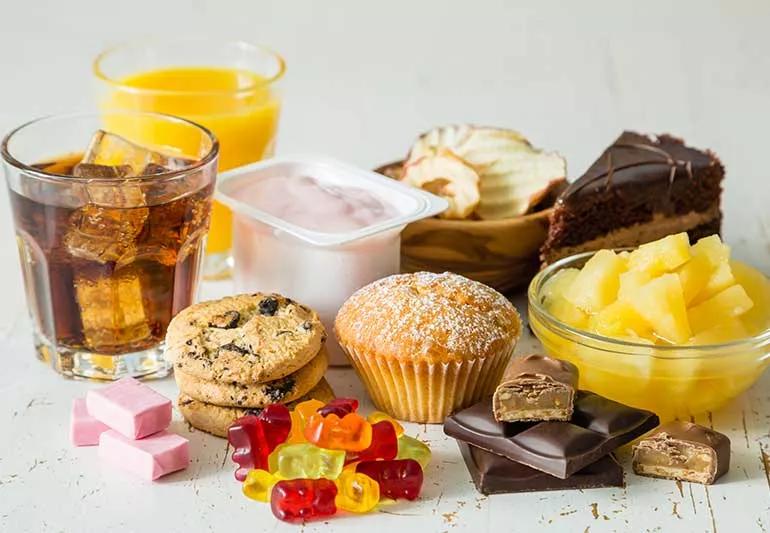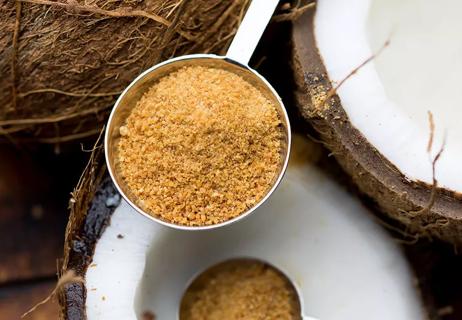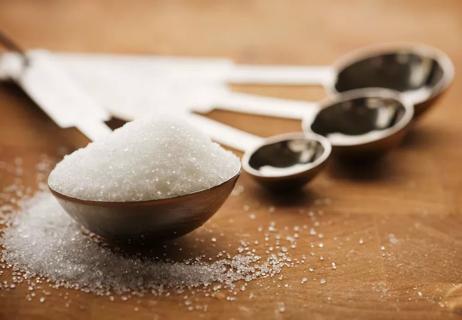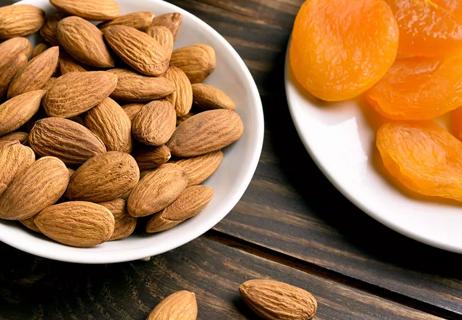Sugary foods don’t always taste sweet, and they may not say ‘sugar’ on the label

Juliet Capulet (of Romeo and Juliet fame) once said, “What’s in a name? That which we call a rose by any other name would smell as sweet.”
Advertisement
Cleveland Clinic is a non-profit academic medical center. Advertising on our site helps support our mission. We do not endorse non-Cleveland Clinic products or services. Policy
Juliet was, of course, speaking of her star-crossed lover, Romeo Montague. But the sentiment is the same when it comes to sugars.
Your body loves sugar and can actually feel addicted to sugar. Because no matter its name (and it goes by a LOT of names), sugar still tastes as sweet.
But like Romeo and Juliet’s ill-fated romance, a dependence on sugar is bound to wind up in heartache. Consuming excessive sugar in your food and drinks puts you at higher risk for Type 2 diabetes, obesity, fatty liver disease, heart disease and more.
“Sugar, sugar substitutes and artificial sweeteners are ubiquitous in processed foods and in our diets,” says registered dietitian Anna Taylor, RD, LD. “Many times, people don’t even realize how much sugar they’re eating because they don’t expect certain foods to be so loaded with it. And the labeling on packaged foods can be unclear.”
When you decide to break up with sugary foods, or at least cut back, it can be hard to know where to start. That’s because the sweet stuff is hiding in just about any bagged, boxed, jarred or frozen food you can imagine.
We talked with Taylor about the expected and unexpected foods that contain surprisingly high amounts of sugar and how you can spot the signs of hidden sugars in your food.
Advertisement
The American Heart Association (AHA) advises limiting added sugars to no more than:
But the average American consumes about three times more sugar per day than those recommendations.
Part of the reason for that, Taylor says, is that sugar hides in more foods than you may know.
Some sugary foods are obvious. You probably already expect that there are high amounts of sugar in cakes, cookies, pastries, pies candies and other baked goods and dessert foods.
But it’s more than that.
The AHA says beverages are the leading source of added sugars in most people’s diets. That includes:
And then, there are sugar-laden foods that don’t set off your sweet tooth but actually include surprising amounts of added sugar. For example:
| Food product | Serving size | Total sugars (rounded) |
|---|---|---|
| Baked beans | 1 cup | 21 grams |
| Bran cereal with raisins | 1 cup | 19 grams |
| Protein bar | 1 bar (53 grams) | 8 grams |
| Barbecue sauce | 1 tablespoon | 6 grams |
| Granola bar | 1 bar (21 grams) | 6 grams |
| Pasta sauce | 1/2 cup | 6 grams |
| Ketchup | 1 tablespoon | 4 grams |
| French salad dressing | 1 tablespoon | 3 grams |
| Food product | ||
| Baked beans | ||
| Serving size | ||
| 1 cup | ||
| Total sugars (rounded) | ||
| 21 grams | ||
| Bran cereal with raisins | ||
| Serving size | ||
| 1 cup | ||
| Total sugars (rounded) | ||
| 19 grams | ||
| Protein bar | ||
| Serving size | ||
| 1 bar (53 grams) | ||
| Total sugars (rounded) | ||
| 8 grams | ||
| Barbecue sauce | ||
| Serving size | ||
| 1 tablespoon | ||
| Total sugars (rounded) | ||
| 6 grams | ||
| Granola bar | ||
| Serving size | ||
| 1 bar (21 grams) | ||
| Total sugars (rounded) | ||
| 6 grams | ||
| Pasta sauce | ||
| Serving size | ||
| 1/2 cup | ||
| Total sugars (rounded) | ||
| 6 grams | ||
| Ketchup | ||
| Serving size | ||
| 1 tablespoon | ||
| Total sugars (rounded) | ||
| 4 grams | ||
| French salad dressing | ||
| Serving size | ||
| 1 tablespoon | ||
| Total sugars (rounded) | ||
| 3 grams |
These figures are based on data from the U.S. Department of Agriculture. The amount of sugar will vary by brand and other factors, but you get the idea.
And if you think getting “sugar-free” versions of these products are a healthier alternative, know that’s not necessarily the case. More on that in a bit.
Sugar and sugar substitutes are rampant in the processed and packaged foods that are common in Americans’ diets. But simply scanning your nutritional labels for the word “sugar” isn’t enough to avoid the many variations of the stuff.
Added sugars can go by many (many!) names. So, it’s important to read between the lines and spot sugar that’s masquerading under an alias.
Start by looking for ingredients on your nutrition labels that include the words “sugar,” “syrup” or words that end in “-ose.” Specifically, Taylor says you can be sure sugar is lurking in your foods if you see any of these ingredients:
But wait. There’s more!
In addition to refined sugar, there’s a whole host of artificial sweeteners that also don’t benefit your health. And artificial sweeteners may be sneakier than refined sugar. That’s because foods that contain artificial sweeteners can be sold in packaged foods labeled as “sugar-free,” “no added sugar” or “diet.”
Advertisement
If you’re looking to cut out the artificial stuff, you’ll want to also scan your labels for these ingredients:
Just when you thought it couldn’t get more complicated, buckle up.
Sugar alcohols are yet another way that processed foods get an added sweet kick.
Sugar alcohols are chemicals similar in structure to sugar. They’re found naturally in some foods in small amounts. But in packaged foods, they’re artificially created and used in large quantities to add a sweet taste while keeping calorie counts low.
Sugar alcohols are commonly used in packaged foods labeled as “low calorie,” “reduced calorie,” “keto-friendly” or “diabetes-friendly.” They go by names like:
Sugar alcohols have Generally Recognized As Safe (GRAS) status from the U.S. Food and Drug Administration (FDA). But recent research is shining a new light on their potential to be problematic.
A recent study shows erythritol, in particular, is closely associated with an increased risk for “major adverse cardiovascular events,” including heart attack and stroke. And other sugar alcohols can cause stomach discomfort for some people.
Advertisement
If you find yourself overconsuming sugary foods, it may be time to reevaluate your relationship with sugar.
Sugar and other sweeteners hijack your body’s reward and pleasure centers, in much the same way that addictive substances do.
“Your body doesn’t need added sugar in order to function,” Taylor explains. “But sugar lowers the availability of your dopamine and opioid receptors. Essentially, it can trick you into thinking you need it.”
Knowing what sugary foods to look out for is a start. Next comes the harder part. Breaking your sugar addiction.
Cutting out added sugar is a lifestyle change. And a big one. So, be easy on yourself, and take it slow, Taylor advises. Think of it less like ripping off a bandage. More like training for a marathon.
Taylor’s top advice:
Advertisement
Avoiding sugary foods is a big commitment — and a commendable one. Know that any steps you can take to lower your intake will benefit your health and lower your risk of chronic disease. Now that’s sweet.
Learn more about our editorial process.
Advertisement

A high-sugar diet can trigger a chain reaction that may raise your risk

You can reduce how much added sugar you consume by tracking what you eat, reading labels and limiting portions of the sweet stuff

A high intake of sugar can cause an increase in ‘bad’ cholesterol and a decrease in ‘good’ cholesterol

Often labeled as ‘diabetes-friendly’ or ‘calorie-free,’ these sugar substitutes warrant caution

There is an indirect link between the sweet substance and the condition

It’s touted as a healthier alternative to cane sugar, but basically, well ... it’s still just sugar

Don’t skip meals or go ‘cold turkey’ — eat a balanced diet and talk to your doctor instead

Fuel your body with healthy options that combine fiber-rich carbs, lean protein and healthy fats

The best parenting style balances enforcing rules and showing plenty of love

Tips include cutting back on sugar, focusing on exercise and managing stress

It can be harder to let go when you’ve invested time, energy and emotions — but it might be the healthier choice long term